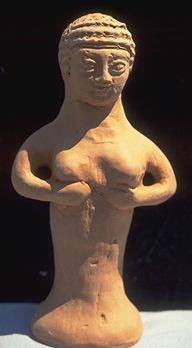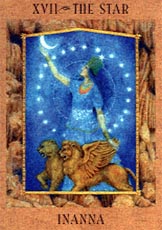
Anahita, Immaculate One |
Anath, Bloody Mistress |
Asherah, Lady Tree |
Astarte, Lady Queen |
Atargatis, Ocean Mermaid |
Cybele, Lady Lioness |
Daena, Lady Guardian |
Husbishag, Lady of the Book |
Inanna, Queen of Heaven |
Nanshe, Lady of Dreams |
The Pari, Kind Djinn |
Shataqat, Lady Healer |
Siduri, Lady of Happiness |
Tashmetu, Lady Who Listens |
Tiamat, Mother Dragon |
The Near East--defined here as the Iranian Plateau east to the Mediterranean, and from the Black and Caspian Seas south through the Arabian Peninsula--is one of the oldest inhabited regions of the world; Jericho is the oldest known city in the world. The Near East is also one of the most excavated regions, and so detailed archaeological records extend back thousands of years. These archaeological records reveal a few surprises. For one, the three Abrahamic religions of Judaism, Christianity and Islam are newborns. Even Zoroastrianism only appeared in Persia circa 600 BCE.
Before the Abrahamic religions, the faiths of Sumeria, Babylonia, Akkadia, Phoenicia and Syria, Anatolia, Armenia and Georgia, Arabia and Persia flourished. Records stretching back thousands of years reveal worship of a Mother Goddess by sedentary agricultural peoples. In some areas, the Goddess was accompanied by a Divine Daughter or two, and/or a Consort/Son. Then, like Greece, the Near East was invaded by patriarchal tribes from the north. Gods gained in power. The well-known pantheons of the region developed, featuring Deities such as Inanna, Ea, Marduk, Baal, El, Astarte. Great ziggurats were constructed in Mesopotamia. The heroic saga of Gilgamesh was written, as were great romances and religious hymns; the oldest surviving written work in the world, a hymn to Sumerian Inanna by the priestess Enheduanna, comes from this time. The Goddesses Whose stories are told here were powerful and loved in ancient days; one, Asherah, even appears in the Bible, as if to stubbornly remind us of Her existence. These Goddesses at one time watched over passion and war, the sea and the desert, the Land of the Dead and the Heaven of Stars.
But the Near East is no longer the home of Goddesses, or even Gods. Only God.
The Near East is the Holy Land to many of the world's faithful; it is the home of Judaism's Abraham, Christianity's Christ, Islam's Prophet. It is a land of color-stripped cliffs, high mountains, hot deserts, cool oasi, olive orchards and goat herds. It is also the home of fundamentalism, tanks, guns, jihad, infata, oil wealth, racial division, car bombs, tombs ancient and modern, hatred and intolerance.
Fundamentalism--whether religious, political, ethnic--is the great scourge of the modern world. Religious fundamentalism in particular, tied to ideas of racial purity, separatism, and moral superiority, may prove the great bain of the next century. To believe implicitly--for one's self--in the rightness of one's faith is all well and good; to have found the faith which resonates with one's soul, which fills the mind with color and music, is a great thing indeed. But to force that faith on others, against their will, is another matter entirely. No one faith will ever satisfy all the peoples of the world; we are all different, in our thoughts and perceptions and needs and experiences; and so the faiths which satisfy us, which resonate with us, will differ. This is a realization--a fact--which few in the world have intellectually recognized and which fewer still have accepted in their hearts.
Back to Introduction
Back to Near Eastern Goddesses
Back to Goddesses
Anahita, Immaculate One
| Her name means "Immaculate One." In the Zoroastrian religion, She is a Goddess of the Moon, Fertility and War. She is the Ruler of Water. The ancient Romans and Greeks considered Her the same as Diana/Artemis and Venus/Aphrodite (see Graeco-Roman section). Her Sister-Goddess was Armaiti (see Creation chapter). |
Back to Near Eastern Goddesses
Anath, Bloody Mistress
| Also known as Anat, She was worshipped throughout Canaan, Syria and Phoenicia. She was a popular Goddess of War and Fertility. She was largely syncretized with Asherah and Astarte (both profiled in this section), and so there is some confusion as to Her myths and relationship to other Deities of the area. |
Back to Near Eastern Goddesses
Asherah, Lady Tree
ASHERAH ©JBL
Back to Near Eastern Goddesses
Astarte, Lady Queen
ASTARTE ©JBL
Back to Near Eastern Goddesses
Atargatis, Ocean Mermaid
| Known to the Romans as Dea Syria, Atargatis was a Goddess of Creation and Fertility. She was usually depicted with a fish tail; hence, Her modern identification as the Mermaid Goddess. Her worship spread to Asia Minor, Greece, Egypt and Rome. |
Back to Near Eastern Goddesses
Cybele, Lady Lioness
CYBELE ©JBL
Back to Near Eastern Goddesses
Daena, Lady Guardian
| Her name means "That Which Has Been Revealed." In Zoroastrian tradition, She is the daughter of Armaiti (see Creation chapter). She is a judge of the dead, who leads them to either Heaven or Hell. |
Back to Near Eastern Goddesses
Husbishag, Lady of the Book
| This Akkadian Goddess of the Underworld keeps a secret book. In it is written the time of death of all living things. |
Back to Near Eastern Goddesses
Inanna, Queen of Heaven
 |
Inanna is a well-known Sumerian Goddess. Her name is usually translated as "Queen of Heaven." Inanna's Babylonian counterpart was Ishtar. She is the Ruler of the Sky, the Earth and the Fertility of all things. She possesses the power of life and death. The most famous of Inanna's myths tells of Her descent to the Underworld to reclaim Her slain Lover, Dumuzi. The following is a retelling of one of Inanna's lesser-known myths; it might well recount a resurrgence of the Goddess faith following the patriarchal invasions. |
INANNA from ART AND WORDS
@Kris Waldherr
Back to Near Eastern Goddesses
Nanshe, Lady of Dreams
| Also known as Nanshebargunu, this Sumerian-Babylonian Goddess was the interpreter of dreams. At the New Year, She judges each person and always shows compassion towards the weak and poor. |
Back to Near Eastern Goddesses
The Pari, Kind Djinn
| Ancient Persians honored the Pari as benevolent beings formed of fire. They lived on the odor of delicious foods and perfume. They are eternally at war with the evil Pairikas. |
Back to Near Eastern Goddesses
Shataqat, Lady Healer
| The story of Shataqat may be based on a real person. This Syrian myth recounts the exploits of a Healer in search of a cure for a King. |
Back to Near Eastern Goddesses
Siduri, Lady of Happiness
| Siduri is the Goddess of Wine, Wisdom and Merry-making. She recognizes the reality of death and encourages Her followers to enjoy all the pleasures of life. She was honored by the Babylonians, Sumerians and Akkadians. She plays an important role in the EPIC OF GILGAMESH. |
Back to Near Eastern Goddesses
Tashmetu, Lady Who Listens
| Tashmetu is said to possess "a wide ear." A compassionate Goddess, She listens to the prayers of Her faithful, and in turn opens their ears to Divine instruction. Her husband is Nebo, God of Teaching and Writing. She was worshipped by the Assyrians, Babylonians and Sumerians. |
Back to Near Eastern Goddesses
Tiamat, Mother Dragon
| Her name means "Bitter Ocean." She may not have been a Goddess, so much as a personification of the primordial waters. The story of Her murder by Marduk, told here, may well recount the overthrow of the Goddess-worshipping culture of ancient Mesopotamia. |
Back to Near Eastern Goddesses
Back to Introduction
Back to Hindu Goddesses
Back to Goddesses